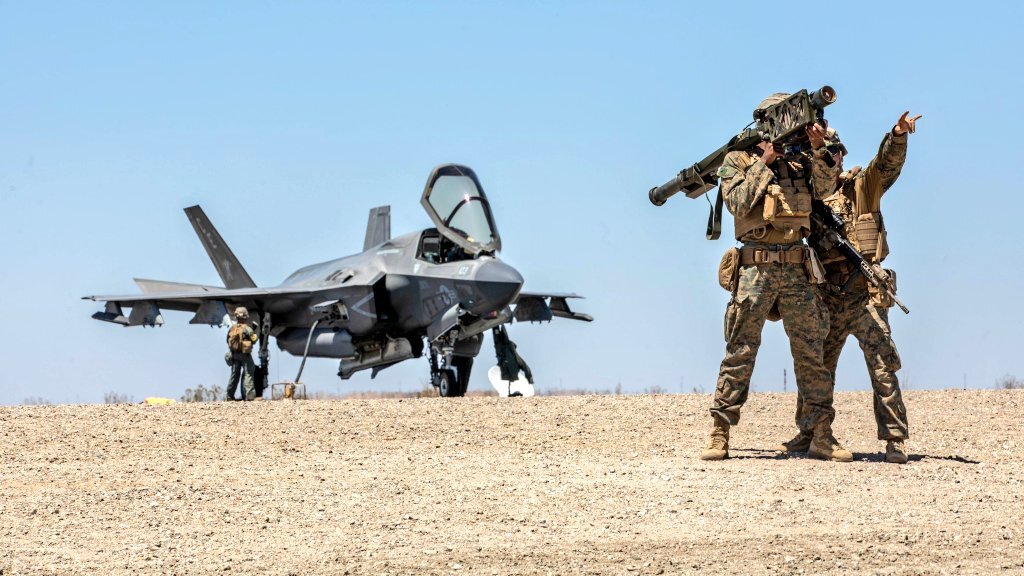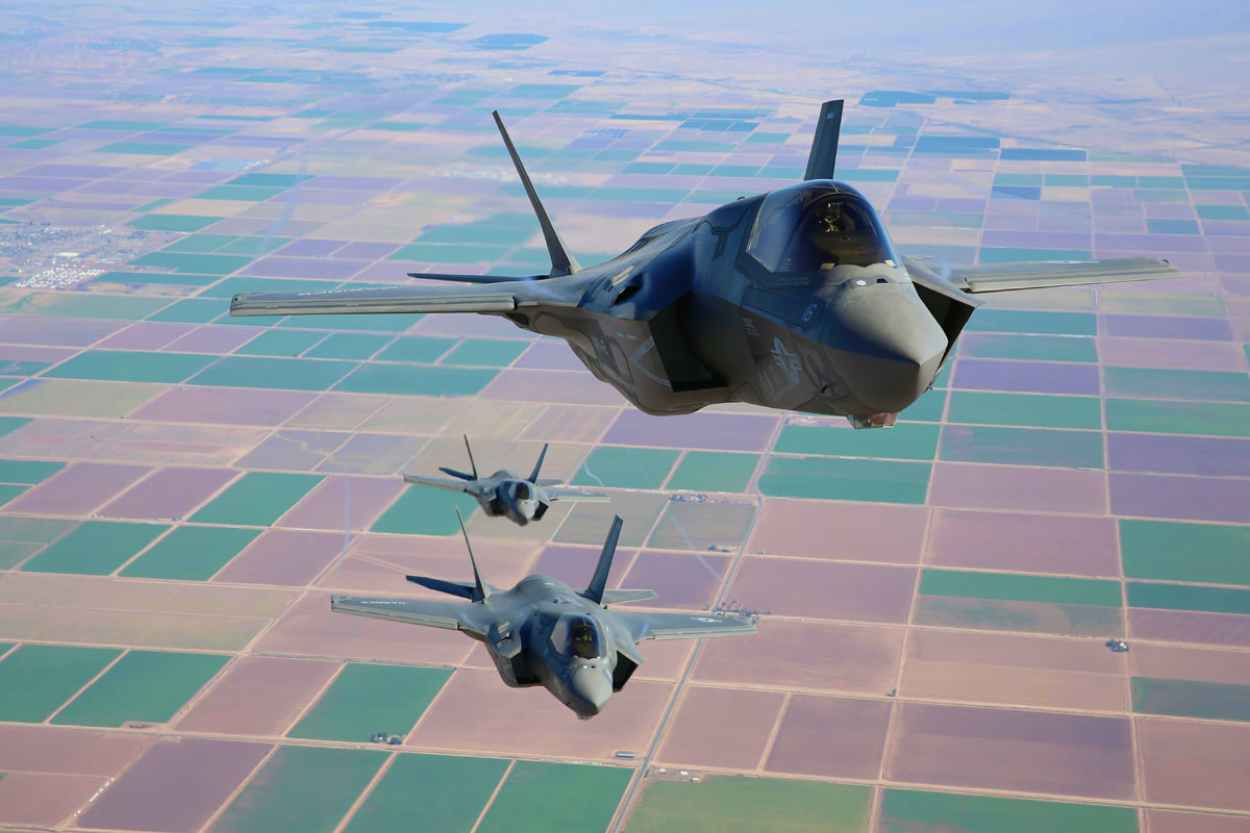The F-35 stealth fighter, particularly its vertical take-off landing (VTOL) ‘B’ variant operated by the US Marine Corps (USMC), is emerging central to its island-hopping role of fighting China inside its anti-access/area-denial (A2/AD) bubble.
A picture of an F-35B operating vertically from a forward base on open ground and being protected by a two-person Stinger MANPAD missile has revealed how the stealth fighter fits into the US Navy’s Expeditionary Advanced Base of Operations (EABO) and the USMC’s Force Design 2030 concepts.
The tweet on Monday carried a picture dated May 2022 of a USMC F-35B on open ground, protected by a two-man Stinger MANPAD team. The same month on May 27 showed a US Marines Corps F-35B departing a Forward Arming and Refueling Point at Yuma Proving Grounds in Arizona.
It was armed with six GBU-12 bombs (four mounted onto the wings and two loaded into the weapons bay) and an AIM-9X air-to-air training missile.
That same year on April 25, the Marine Operational and Test Evaluation Squadron followed it up with a ‘risk reduction effort’ with an F-35B at the Marine Corps Air Station in Yuma.
“The risk reduction effort tested flight clearance operations for short landings and take-offs on prepared and semi-prepared surfaces,” the USMC said in a Tweet.

A month later, in June of that year, an F-35B assigned to the 13th Marine Expeditionary Unit (MEU) was practicing operating from “austere environments” and “rolling vertical landing training.”
The exercises are a part of the USMC’s island-hopping tactic of small, agile, hard-to-detect, anti-air and anti-ship missile armed Marines on friendly islands in the South China Sea (SCS), meant to fight China inside its Anti-Access/Area Denial (A2/AD) bubble.
Fight China Inside The A2/AD Umbrella
Part of the USMC’s Force Design 2030 Expeditionary Advanced Base of Operations (EABO) and the US Navy’s Distributed Maritime Operations (DMO) concept, the plan encompasses aerial and naval components which would operate in conjunction with the Marine units on these islands.
Logistics is one perennial challenge the US military has been trying to overcome, as discussed in multiple previous analyses in the EurAsian Times.
The vast distances between the First and Second Island Chains and the operational area in the SCS and East China Sea (ECS) make it incredibly difficult and risky for US warships and the island-based Marines to be resupplied with fuel, food, and firepower while China can keep comfortably fighting from the home front.
But on December 8 last year, the plan began crystallization when two F-35Bs from the USMC Operational Test and Evaluation Squadron One (VMX-1) landed at Camp Pendleton in Southern California.
“The F-35s did not land on the mountainous base’s 6,000-foot runway. Instead, they did so at the smaller and far more austere Helicopter Outlying Field (HOLF),” said a report in The Drive.
Challenges In Operating F-35Bs From Austere Environments
VMX-1 called the test Obsidian Iceberg. The distributed operations concept exploits the F-35B’s runway Vertical Take-Off Landing (VTOL) capability by making it operate from remote locations with little logistical support and no runways.
The goal was to train Marine ground, maintenance, logistics, and communications units to integrate and expose them to operate from such environments. For instance, using the F-35’s data link with Marine ground elements and the tilt-rotor V-22 Osprey aircraft to ready whatever maintenance, repair, spare parts, fuel, and armament the jet might need.
Another challenge is doing this in a contested space with a peer and electronically advanced adversary like China, which can intercept radio communications and either jam those or use them to locate the units.
Such an arrangement reveals an incredibly tall order – an F-35B, with a combat radius of not more than 650 miles, has to communicate complex needs with ground crew and logistics in the least possible time frame in a near-radio silence environment and land vertically at the base.
Then, be refueled, rearmed, and possibly repaired rapidly before the enemy fire comes raining down. Refining these Tactics-Training-Procedures (TTP) is what the experiment focused on.
But ordnance, unlike fuel, cannot be transferred to aircraft while airborne; this is where the EABO differentiates itself from the Forward Arming and Refueling Point (FARP). “Unlike the traditional Forward Arming and Refueling Point (FARP), EABO can quickly set up and quickly break down because sometimes the EABO will be inside the weapons engagement zone of the enemy,” the Drive said.
But the Marines’ challenge was to refine landing procedures on the road on the eastern Pacific Coast in California at Camp Pendleton – where the tests were happening.
With Obsidian Fury, the Marines managed to get clearance for landing the F-35B on roads that are 53 feet wide since that would be the area realistically available on islands in the western Pacific. The last challenge was avoiding Foreign Object Damage (FOD) while operating the F-35Bs in such crude and austere environments.
The exercise at Yuma Proving Grounds, therefore, mentioned a FARP scenario and showed a Stinger Man-Portable Air Defense (MANPAD) team, which the Marines are preparing for a miniaturized version of airfield defense.
When considering how USN and USMC planners are also looking at ‘lightning carriers,’ where Landing Helicopters Docks (LHD) carry several F-35, instead of the larger supercarriers, the F-35 is emerging as the ‘tip of the spear’ of the US’ possible war against China.

F-35s & Marine Units No Panacea
However, the USN and the USMC’s plan is not foolproof and far from being the decisive advantage against China’s A2/AD bubble. The 2019 Marine Aviation Plan specifies the EABO as a “coercive but not (an) escalatory” tool.
This means apart from merely conveying to the People’s Liberation Army (PLA) that the US has options to complicate and harass its military maneuvers, it is far from being able to push back a Chinese armada and take the fight to the mainland.
In a purely military and tactical scenario, the Chinese have many options for eventually detecting hidden Marine units on these islands. It has the largest and most diverse inventory of armed and unarmed drones, a competent satellite network (to obtain the most accurate targeting information), and a varied battery of possibly tens of thousands of surface attack missiles to eventually find and permanently destroy the Marine Littoral Regiments (MLR).
Its Northern Theater Command (NTC), Eastern Theater Command (ETC, which is concerned with Taiwan), and Southern Theater Command (STC) have enough aerial and naval resources to tackle the Marine units at Okinawa or Yonaguni islands.
By no stretch of the imagination will tackling the MLRs be a drain on the resources of either of these commands. It would be naïve not to expect the PLA not to have a tactical and operational plan in place for tackling the MLRs.
They have missiles, drones, special forces, amphibious ships and tanks, and electronic warfare capabilities to destroy MLRs; its own highly advanced naval and regular air force to take out the F-35s, the V-22 Ospreys or the CH-53Ks and; the world’s largest navy, combined with a vast civilian naval militia and under-development sea-borne Unmanned Surface Vessels (USV) to hit the US Navy logistics ships that would be feeding the MLRs.
It depends on which element it chooses to destroy and at what point in a potential US-Japan-Taiwan confrontation.
- The author can be reached at satamp@gmail.com
- Follow EurAsian Times on Google News




